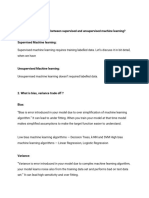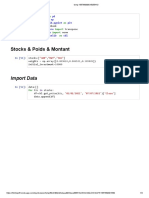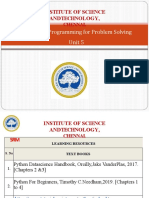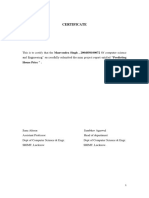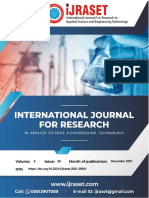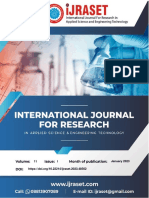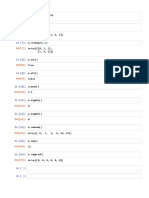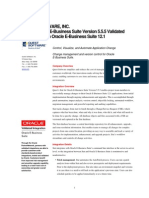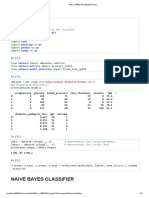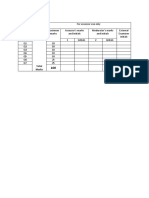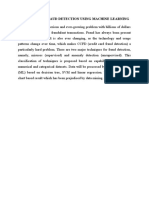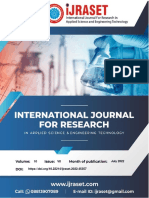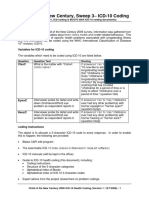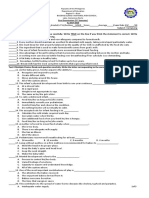Professional Documents
Culture Documents
Detecting Alzheimer's Disease Using Brain MRI
Original Title
Copyright
Available Formats
Share this document
Did you find this document useful?
Is this content inappropriate?
Report this DocumentCopyright:
Available Formats
Detecting Alzheimer's Disease Using Brain MRI
Copyright:
Available Formats
Volume 7, Issue 7, July – 2022 International Journal of Innovative Science and Research Technology
ISSN No:-2456-2165
Detecting Alzheimer’s Disease Using Brain MRI
Aafreen
Dept. Of CSE, IGDTUW, New Delhi, India.
Abstract:- A neurological condition called Alzheimer's months and the latter is in a reasonably stable state without
disease causes the death of brain cells. Dementia, which is lesions. Although there is no treatment for the disease, there
characterised by a loss of analytical skills and the ability are some guidelines that can be followed to assist halt its
to carry out daily duties independently, is most frequently growth. Therefore, a correct diagnosis will be crucial to
caused by this. People of all ages are susceptible to the enhancing the victim's quality of life.
dementia known as Alzheimer's disease (AD). Recently,
these indicators have been quickly incorporated into the The Alzheimer's disease symptoms include: inability to
signs and symptoms of Alzheimer's disease (AD) using recall recent events or conversations, lack of interest,
classification frameworks that provide diagnostic tools. depression, poor judgement, unanswerable, confusion,
This study conducts a thorough review of published behavioural changes in advanced stages of the disease.
studies on Alzheimer's disease with a focus on computer-
aided diagnosis techniques such as magnetic resonance
imaging (MRI), computerised tomography (CT) scans,
imaging with diffusion tensors, and PET scans (positron
emission tomography). This article reviews some of the
most recent research on Alzheimer's disease and discusses
how machine learning (ML), deep learning (DL), and
other brain imaging techniques can help with an earlier
identification of theAt the conclusion of this research, a
CNN model that incorporates Densenet 169, EfficientNet,
and VGG-16 has been created to identify Alzheimer's
disease using Magnetic Resonance Imaging (MRI) data.
The Kaggle Alzheimer's dataset is used in experiments,
and the results demonstrate that the suggested models
had excellent accuracy.
Keywords:- Neurogenerative illness, Dementia, Alzhiemer's
detection, Deep Learning, and Machine Learning.
I. INTRODUCTION Fig 1: The progression of AD from MCI to severe AD
[image source:
Alzheimer's disease is a congenital, immutable https://en.wikipedia.org/wiki/Alzheimer%27s_disease]
condition of brain that impairs one's ability to do basic tasks
as well as memory and cognition. It can causes a large number A patient suspected of having Alzheimer's disease
of neurons to stop firing and synaptic connections to be should undergo many examinations, including a neurological
broken. Alzheimer's disease is less common in those between examination, magnetic resonance imaging (MRI) testing, and
the ages of 30 and 60. Sleep difficulties, anxiety, and a review of the patient's medical and family history.
difficulty performing fundamental functions such as reading
and writing, as well as aggressive behaviour and poor In order to ascertain whether a patient with memory or
decision-making, are all indications of Alzheimer's disease. cognitive issues has Alzheimer's disease, doctors use a
An early brain abnormalities develop 10–20 years before number of tests and technology. In order to diagnose
symptoms appear. Over time, it reduces cognitive ability and Alzheimer's disease, doctors may interrogate the patient
induces memory loss. about their overall health, medication use, diet, prior medical
issues, and ability to perform daily duties. It is recommended
The most frequent cause of this condition is dementia. to perform a brain scan using a computed tomography,
According to a poll, dementia affects 50 million people magnetic resonance imaging, or positron emission
worldwide, with the figure likely to reach 13.8 million by tomography machine. Similar tests may be administered
2060. Dementia affectsapproximately 65 percent of people in again in the future by medical professionals to evaluate how
low-income countries according to World Health the memory and other cognitive abilities have evolved of a
Organisation. patient. Other possible causes of memory loss. Some of these
conditions can be treated and even reversed. Every six to
There are two types of Mild cognitive impairment one twelve months, people with memory issues should see a
is progressive MCI and other is stable MCI, where the former doctor. The only way to detect if someone had Alzheimer's
will eventually advance into Alzheimer's disease within 36 disease before the early 2000s was to do an autopsy, which is
a post-mortem operation.
IJISRT22JUL679 www.ijisrt.com 695
Volume 7, Issue 7, July – 2022 International Journal of Innovative Science and Research Technology
ISSN No:-2456-2165
The following is how this paper is organised: The atrophy also gets worse. In this clinical stage, the cortical
introduction, background, and stages of Alzheimer's disease atrophy is already apparent. Later on, however, the
are covered in Section I. The relevant research and ventricular dilatation becomes more apparent.
assessment in the field are covered in Section II, and the
various techniques for diagnosing and classifying Positron Emission Tomography (PET)
Alzheimer's disease are also covered in this section. In PET scanning is a way of producing a 3D brain image at
Section III, the datasets used to identify Alzheimer's disease the anatomical and sub anatomical levels using a volumetric
are described. Section IV discusses methodology and V subatomic illustration method. During PET scanning, a
discusses methodology. In Section VI, future aspects and radioactive isotope that is administered or breathed is
conclusions are reached. referred to as a tracing agent or radiotracer. This serves as
the subject's positron-emitting standard. The scanning
II. RELATED WORK apparatus then finds the radiotracer. The radiotracer is then
distributed throughout the body of the individual in a digital
A number of studies have recently used imaging data image produced by the scanner (illustration). The kind of
to aid in the development of medicines that target the radiotracer employed determines the type of the PET
underlying brain alterations at each stage. The Alzheimer's scan.PET scanning has become more expensive due to the use
disease neuroimaging initiative is a data resource that of cyclotron agents, which are required in the manufacturing
provides researchers with datasets such as MRI, DTI, CT of radiotracers. It can beargued from the fact that brain function
and PET pictures. MRI is a technique for imaging the is dependent on blood sugar consumption. The PET scan has a
anatomy of the brain, and it is one of several picture data unique potential to predict Alzheimer's disease even with
formats. MRI can be used to diagnose atrophy by measuring modest symptoms. PET scanning is a veryeffective diagnostic
the amount of grey and white matter in the brain. tool, but it is not a healthy diagnostic technique for the reasons
described above.
A. Some brain imaging techniques for Alzheimer’s Disease
are as follows :- Magnetic Resonance Imaging (MRI)
MRI is the main method used by humans to examine
Computerized Tomography (CT) Scan brain tissues (MRI). It is helpful in the Alzheimer's disease
According to the findings, the characteristics-based detection and has the capacity to accurately depict the
categorization criterion provides promising results in terms of inner workings of the brain. The diagnosis of diseases
detecting the condition and assisting clinical development. using MRI data is a frequent practice. During the MRI
It's probable that Alzheimer's patients' cerebral atrophy is procedure, the area that needs to be imaged is assaulted
caused by disease processes rather than the brain's natural with magnetic radiation.
ageing process. As the condition worsens, the degree of
Author Methodology Dataset Images Accuracy
“F. Nazir et al.”[31] Transfer Learning OASIS MRI 92.85%
“Y. Shen, et al.” [32] Transfer Learning OASIS MRI 90.6%
“D. Shen et al.” [33] Multi-DomainTransfer Learning ADNI MRI 94.7%
“L. Guibas et al.”[34] ImageNetTransfer Learning ADNI MRI 83.5%
“F. Nazir et al.” [35] Transfer Learning OASIS MRI 98.41%
“S. Wang et al.”[36] SVM OASIS MRI 80%
“J. Ramirez etal.”[37] SVM PET MRI 96%
“N. Kodikara etal.”[38] CNN ADNI MRI 96%
“Cui et al.”[39] RNN ADNI MRI 89.7%
“Liu et al.”[42] 3D CNN ADNI MRI, PET 91.40%
“Nawaz etal.”[43] Alexnet OASIS MRI 92.85%
Table 1: Comparison of different brain imaging techniques used for AD’s detection
B. To detect Alzheimer's disease, various Machine Learning The authors of [3-5] combined the prediction algorithms
and Deep Learning techniques are employed. Random Forest, k-Means and Region Growing. The k-Means
The research indicates that the characteristics-based algorithm was used to cluster the MRI images. Using the
categorization criterion offers promising results for region Growing approach, the white and grey matter were
diagnosing the illness and improving therapeutic care. Deep separated from the clustered pictures. The condition was
learning, Bayesian, K-Nearest Neighbor, and Support Vector categorised as having neuro-anatomical constraints or not
Machine are the classifiers that are most frequently used to using the data collected and the Random Forest approach.
diagnose AD.
In order to overcome the constraints of the machine
The author used support vector machines in [1] to draw learning approach, the author of article [6] developed a deep
out the most significant high-level features from MRI scans learning method for recognising AD that uses a softmax
and pinpoint the different stages of Alzheimer's disease. output layer and stacked auto-encoder. The suggested
IJISRT22JUL679 www.ijisrt.com 696
Volume 7, Issue 7, July – 2022 International Journal of Innovative Science and Research Technology
ISSN No:-2456-2165
approach successfully distinguished Alzheimer's disease as Springer, Elsevier, IEEE, MDPI, and others. From a pool
from mild cognitive impairment and other types of dementia. of roughly 40 papers published in the recent five years, 16
have been picked for their relevance, quality, and easy of
During research phase of this study, a literature review comprehension in our chosen field. The table below contains
was conducted using reputable publications from portals such a list of them.
S No. Author Approach
1 “ Islam et al” [16] Create a trio of slightly different deep convolutional neural network setups as an ensemble.
2 “R. Cui etal” [20] By stacking the input block, Conv block, fully connected block, and Softmax layer, the 3D deep
CNN is created.
3 “L.V.Fulton et al” [17] Keras is used for creating models and uses ResNet with50 layers.
4 “Latha R Set al” [22] With the use of CNN and the VGG16 model, six alternative categorization models are applied
for the various stages of AD.
5 “Atif CNN based approach is used which is inspired by VGG-16. In the VGG-16 model insert one
Mehmood et al” [11] extra convo layer and check its effectiveness
6 “M.Dua et al”[18] Uses the ensemble learningmodel by combing the algorithms like CNN-RNN-LSTM .
7 “Katzourou, I. Ket al” A systematic approach (PRISMA) is used, Twelve studies were found to meet the requirements
[45] for inclusion.
8 “M. Tanveer et al”[3] The main machine learning techniques they employed were support vector machine, artificial
neural network, deep learning, and ensemble methods.
9 “T.Jo et al” [28] Without pre-processing for feature selection, deep learning algorithms like CNN and RNN are
employed with neuroimaging data.
10 “S. Sarraf et al” [26] The researchers used fMRI and MRI pipelines, as well asa decision-making algorithms.
11 “Khan A et al”[48] The model starts with a pre-processing stage and then moves on to imperative attributes.
Association rule mining is used to achieve selection and categorization.
12 “Oscar Darias The state of the art of medicalimage analysis and AD with AI, until early 2019, has been
Plasencia al” [51] analyzed and summarized.
13 “Crous-Bou et al” [50] They discuss the emergence of public–private partnershipsfor disease prevention after
summarising the information on several AD risk variables.
14 M.Maqsoo et al”[31] By optimising a pre-trained convolutional network using an efficient transfer learning method,
the proposed system recognises the images. AlexNet.
15 “S. Afzal et al”[35] They use the OASIS dataset and a transfer learning method with the help of data augmentation
for 3D magnetic resonance imaging views.
16 “Y. Zhang et al”[36] Atlas-registered normalisation was used as a preprocessing step on three dimensional MRI
images.
Table 2: Comparison of several Machine Learning and Deep Learning methods for Alzheimer's disease detection
III. DATASET DESCRIPTION for classes where there is still little data.
Online datasets are available for free. For research on In general, the pipeline in this test can be seen in Figure
Alzheimer's disease, ADNI and OASIS datasets are 2. Initially, there was loading and re-dividing the dataset. The
incredibly helpful. These datasets produce appealing, freely dataset is divided into "train", "val", and "test" with ratio of
usable reverberation images of the brain. This study looked 70:15:15. After that, there is a process of augmentation of
into using deep learning to detect Alzheimer's illness using data to balance the dataset. Then, there is an importation of
the Alzheimer's dataset, which consists of four classes of the model from tensorflow as well as the addition of layers
photographs. Two files, Training and Testing, make up the and optimizers. We've tested some additional layer
dataset, with a combined total of about 5000 photos in each combinations so that the layers used in the final result are
file, each categorised according to the degree of Alzheimer's. already quite good. After that, the data that has been
The dataset includes MRI pictures in the following four processed earlier goes to the training. The output of this
categories: mildly, very mildly, not at all, and moderately training is the data and plot of the training history as well as
demented. the final model obtained. Next, there is an evaluation whose
output is the matrix.
IV. METHODOLOGY
The discussion here includes things that were done
The dataset used in this test was obtained from kaggle. during testing. In testing, the initial step is of course to enter
The dataset contains about 5000 images consisting of four the data. Next, several functions from various modules are
classes (Moderate Demented, Mild Demented, Very Mild imported, mainly from tensorflow modules.
Demented, and Nondemented or normal). However, the data
is very unbalanced.Therefore, there needs to be augmentation
IJISRT22JUL679 www.ijisrt.com 697
Volume 7, Issue 7, July – 2022 International Journal of Innovative Science and Research Technology
ISSN No:-2456-2165
Fig:2 Proposed methodology for Alzheimer’s Detection
After those various initializations, there is a preliminary The next step is Image Loading and Transformation.
definition. This includes defining the values of important Initially, there was a definition for load and transform images
parameters used in the test, such as data split ratios, via Image Data Generator. The image goes into the generator
parameters for Image transformation, the number of epochs to be randomly transformed so that there is no longer an exact
and batch sizes, and parameters for the optimizer. duplicated image. That way, the class can be more balanced
with data that remains diverse. The next part is testing with
The defined functions are functions for plot training Densenet169, EfficientNet and VGG16 models. Previously,
history and storing its data, functions for model evaluation, as it was necessary to import the initial model from tensorflow.
well as functions for creating matrices and storing them. Imported models already have pretrained weights for image
Then, a random re-division of the dataset is carried out using processing. Next, there is the addition of several layers. The
a specific function. In addition, there is a process of activation function used is relu. What layers need to be added
duplicating image files so that many of the files reach a are the result of several tests and literature reviews.
certain number. The existing image files are duplicated in
order until they can be sufficient. If it is not enough, then the V. RESULT AND ANALYSIS
process is repeated from scratch. This duplication process is
only done for "training" data that requires class balance. The transfer learning method produces the most
These splits and duplications are done before Image accurate results, but it necessitates a substantial amount of
Transformation. If the data is transformed first and then labelled data and demanding computer capabilities. Deep
shared, there will be a very similar image in the train and test network models that have already been trained and validated
data so that the testing is unfair. for transfer learning include Densenet, VGG, and
EfficientNet. The main crux of different model is summarized
below.
ModelName Train_Acc Precision Recall Auc
DenseNet 0.9840 0.9739 0.9619 0.9982
EfficientNet 0.7401 0.4616 0.2373 0.7527
VGG16 0.9694 0.9450 0.9320 0.9951
Table 3: Final result of all three models
IJISRT22JUL679 www.ijisrt.com 698
Volume 7, Issue 7, July – 2022 International Journal of Innovative Science and Research Technology
ISSN No:-2456-2165
The table above provides some conclusions. that the best Confusion Matrix
classification accuracy was received by Desnset169 having The previous result are actually enough to show the
categorical accuracy of 98% followed by VGG 16 with a performance of the model. However, to better understand
categorical accuracy of 96 % and EfficientNet model how the model deals with existing data, a confusion matrix
accuracy of 74% . can be used. The matrix for all three models can be seen in
Figure 3
Fig 3: Confusion matrix of all models used
This matrix demonstrates how the model categorises REFERENCES
already-existing data before comparing it to the label. The
better the model, the higher the diagonal part's value in [1]. C. Stolojescu-Crisan, S. Holban, "A comparison of x-ray
relation to the other components. This is so because the image segmentation techniques,"Advances in Electrical
diagonal portion displays the situation at the time the and Computer Engineering, pp.85-92, 2013,
prediction and actuality match. [2]. V. Lebedev, E. Westman, G. J. P. Van Westen, M. G.
Kramberger, A. Lundervold, D. Larsland, et al.,
VI. FUTURE ASPECT AND CONCLUSION “Random Forest ensembles for detection and prediction
of Alzheimer's disease with a good between cohort
To properly treat Alzheimer's disease, early robustness”, NeuroImage: Clinical Journal, pp. 115-
detection is essential. Because the number of cases of 125, 2014.
Alzheimer's disease is rising at an alarming rate, advanced [3]. M. Tanveer, M., Richhariya, B., Khan, R. U., Rashid, A.
technology is needed to treat the disease. Many biomarker, H., Khanna, P., Prasad, M., & Lin, "Machine learning
proteome, and genomic studies have been conducted in recent techniques for the diagnosis of Alzheimer’s disease: A
years and will continue to be conducted in the future. Despite review." ACM Transactions on Multimedia Computing,
these research, there remain a number of challenges to Communications, and Applications ,2020,pp: 1-35.
overcome. To battle the disease, technology alone will not [4]. U. R. Acharya, S. L. Fernandes, J. E. Wei Koh, E. J.
suffice, standardisation of procedures and approaches is Ciaccio, M. K. M. Fabell, U. J. Tanik etal. ,“Automated
essential for maintaining consistency and reaching a high detection of Alzheimer’s disease using brain MRI
level of reliability. In this study, we discussed Alzhiemer's images– A study with various feature extraction
disease, its stages in detail. This study focuses on brain techniques” Journal of Medical Systems, vol.43, pp.1-8,
imaging approaches for alzheimer's illness, Machine 2019,
Learning, and Deep Learning methods for alzheimer's [5]. Mohamed M. Dessouky and Mohamed A. Elrashidy
detection. When it comes to classification and detection ”Feature extraction of the Alzheimer’s disease images
approaches, CNN is the most commonly utilised models in using different optimization algorithms,” Journal of
this area. For testing our proposed method, we have explored Alzheimer’s Disease & Parkinsonism , vol.6, pp.1-11,
the Alzheimer's Dataset freely available on Kaggle. 2016,
Exploratory data analysis has been performed on it. A [6]. S. Liu, S. Liu, W. Cai, S. Pujol, R. Kikinis and D. Feng,
comparative study has been done using Transfer Learning "Early diagnosis of alzheimer's disease with deep
models. The best classification accuracy was achieved by learning," IEEE 11th International Symposium on
DenseNet169 when compared with other transfer learning Biomedical Imaging (ISBI), Beijing, pp. 1015-1018,
models (EfficientNet, VGG16). 2014
[7]. U. R. Acharya, S. L. Fernandes, J. E. Wei Koh, E. J.
Ciaccio, M. K. M. Fabell, U. J. Tanik et al. ,“Automated
detection of Alzheimer’s disease using brain MRI
images– A study with various feature extraction
techniques” Journal of Medical Systems, pp.1-8, 2019.
IJISRT22JUL679 www.ijisrt.com 699
Volume 7, Issue 7, July – 2022 International Journal of Innovative Science and Research Technology
ISSN No:-2456-2165
[8]. Mohamed M. Dessouky and Mohamed A. Elrashidy [24]. S. Liu , S. Liu , W. Cai ,S. Pujol ,R. Kikinis ,D. Feng,
“Feature extraction of the Alzheimer’s disease images “Early diagnosis of Alzheimer's disease with deep
using different optimization algorithms,” Journal of learning”, pp. 1015-1018,31 July 2014. IEEE
Alzheimer’s Disease & Parkinsonism , pp.1-11, 2016. [25]. S. Luo1, X. Li, J. Li; “Automatic Alzheimer’s Disease
[9]. J. Dukart, K. Mueller, H. Barthel, A. Villringer, O. Recognition from MRI Data Using Deep Learning
Sabri, M. L. Schroeter, “Meta analysis based SVM Method”, Journal of Applied Mathematics and Physics,,
classification enables accurate detection of alzheimer’s pp.1892-1898, 16 October 2017, IEEE.
disease across different clinical centers using FDG-PET [26]. S. Sarraf, D. D. DeSouza, J. Anderson, G. Tofighi,
and MRI,” Psychiatry research, pp. 230- 236, 2013. “DeepAD: Alzheimer’s Disease Classification via Deep
[10]. K. Ota, N. Oishi, K. Ito, H. Fukuyama , J. Sead, Study Convolutional Neural Networks using MRI and Fmri”,
Group & Alzheimer's Disease Neuroimaging Initiative, August 2016,
“Effects of imaging modalities, brain atlases and feature [27]. S. Sarraf, G. Tofighi, “Classification of Alzheimer's
selection on prediction of Alzheimer's disease,” Journal Disease using fMRI Data and Deep Learning
of Neurosci Methods, pp.168- 183, 2015, Convolutional Neural Networks”,2 arXiv preprint
[11]. Mehmood, M. Maqsood, M. Bashir,3 and Yang arXiv:1603.08631 , 2016.
Shuyuan1“A Deep Siamese Convolution Neural [28]. T.Jo, K. Nho.,A.J. Saykin, “Deep Learning in
Network for Multi-Class Classification of Alzheimer Alzheimer's Disease: Diagnostic Classification and
Disease”,p 84,5 feb 2020. Prognostic Prediction Using Neuroimaging Data”,p
[12]. Mikołajczyk , M. Grochowski, “Data augmentation for 220, 20 Aug 2019,
improving deep learning in image classification [29]. T. Kaur; T. K. Gandhi, “Automated Brain Image
problem”, pp 177-122,21 June 2018. Classification Based on VGG-16 and Transfer
[13]. A. Moscoso, J. Silva-Rodríguez, J. M. Aldrey,J. Cortés, Learning”,pp 94-98, 12 March 2020.
A. Fernández-Ferreiro, N. Gómez- Lado,Á. Ruibal, P. [30]. X. Hong; R. Lin; C. Yang; N. Zeng; C. Cai; J. Gou; J.
Aguiar, “Prediction of Alzheimer's disease dementia Yang, “Predicting Alzheimer’s Disease Using LSTM”,,
with MRI beyond the short-term, p.101837 ,30 April ieee Access, 7, pp.80893-80901,2019.
2020. [31]. M. Maqsood, F. Nazir, U. Khan, F. Aadil, H. Jamal, I.
[14]. Deep learning for Data Analytics, “Deep learning for Mehmood, “Transfer Learning Assisted Classification
early diagnosis of Alzheimer’s disease: a contribution and Detection of Alzheimer’s Disease Stages Using 3D
and a brief review”, pp.63-78, 2020, MRI Scans 2645, 2019.
[15]. Gupta A., Ayhan M.S., Maida A.S; “Natural image [32]. S. Wang, Y. Shen, W. Chen, T. Xiao, and J. Hu,
bases to represent neuroimaging data”, pp. 987-994, “Automatic recognition of mild cognitive impairment
30th Int. Conf. Mach. Learn. 2013. from mri images using expedited convolutional neural
[16]. J, Islam, Y. Zhang, “Brain MRI analysis for Alzheimer’s networks,” in International Conference on Artificial
disease diagnosis using an ensemble system of deep Neural Networks, 2017, pp. 373-380. Springer.
convolutional neural networks”,pp 1-14, 2018. [33]. B. Cheng, M. Liu, D. Shen, Z. Li, D. Zhang, and A. s.
[17]. L. V. Fulton, D. Dolezel ,J. Harrop ,Y. Yan 1 and C. P. D. N. Initiative, “Multi-domain transfer learning for
Fulton, “Classification of Alzheimer’sDisease with and early diagnosis of Alzheimer’s disease,”
without Imagery Using Gradient Boosted Machines and Neuroinformatics, pp.115-132, 2017.
ResNet-50”, p 212, 22 August 2019. [34]. T. Glozman, J. Solomon, F. Pestilli, and L. Guibas,
[18]. M. Dua, D. Makhija, P. Y. L. Manasa and P. Mishra, “Shape-Attributes of Brain Structures as Biomarkers
“CNN–RNN–LSTM Based Amalgamation for for Alzheimer’s Disease,” Journal of Alzheimer’s
Alzheimer’s Disease Detection”, pp.688-706, 28 July Disease, pp.287-295, 2017
2020. [35]. S. Afzal, M. Maqsood, F. Nazir, U. Khan, F. Aadil, K.
[19]. P. Y. Simard, D. Steinkraus, J. C. Platt, “Best Practices M. Awan, et al., “A Data Augmentation-Based
for Convolutional Neural Networks Applied to Visual Framework to Handle Class Imbalance Problem for
Document Analysis”,pp 1527–1554. 2003. Alzheimer’s Stage Detection,” IEEE Access, 2019,
[20]. R. Cui, M. Liu; “RNN-based longitudinal analysis for pp.115528-115539.
diagnosis of Alzheimer’s disease”, April 2019, Vol. 73, [36]. Y. Zhang, S. Wang, and Z. Dong, “Classification of
Pg. 1-10; Alzheimer disease based on structural magnetic
[21]. R. Jain; N. Jain; A. Aggarwal, D. J. Hemanth, resonance imaging by kernel support vector machine
“Convolutional neural network based Alzheimer’s decision tree,” Progress In Electromagnetics Research,
disease classification from magnetic resonance brain 2014. pp.171-184.
images”, October 2019, Pg.147-159, Vol. 57. [37]. M. Lopez, J. Ramirez, J. Gorriz, D. Salas-Gonzalez, I.
[22]. R. c. suganthe, R. S. latha, M. geetha1, G. r. sreekanth, Á. Lvarez, F. Segovia, et al., “Neurological image
“Diagnosis of Alzheimer’s Disease from Brain classification for the Alzheimer’s Disease diagnosis
Magnetic Resonance Imaging Images using Deep using Kernel PCA and Support Vector Machines,” in
Learning Algorithms”. Pp 57-64, 2020, Nuclear Science Symposium Conference Record
[23]. S. Al-Shoukry, T. H. Raseem, and N. M. Makbol, (IEEE), 2009, pp. 2486-2489.
“Alzheimer’s Diseases Detection by Using Deep
Learning Algorithms: A Mini-Review”, pp.77131-
77141.21 April 2020, IEEE
IJISRT22JUL679 www.ijisrt.com 700
Volume 7, Issue 7, July – 2022 International Journal of Innovative Science and Research Technology
ISSN No:-2456-2165
[38]. K. Gunawardena, R. Rajapakse, and N. Kodikara, [51]. Óscar Darias Plasencia ( 23 july 2019) Personalized
“Applying convolutional neural Networks for pre- Medicine: Comparison of Techniques for the
detection of alzheimer’s disease from structural MRI Automatic Diagnosis of Alzheimer's Disease, pp 1-8 .
data,” in Mechatronics and Machine Vision in Practice
(M2VIP), 2017 24th International Conference on,
2017,pp 1-7.
[39]. R. Cui, M. Liu, and G. Li, “Longitudinal analysis for
Alzheimer’s disease diagnosis using RNN,” in
Biomedical Imaging (ISBI 2018),15th International
Symposium on, pp. 1398-1401. IEEE, 2018.
[40]. C. Saraiva, C. Praça, R. Ferreira, T. Santos, L. Ferreira,
and L. Bernardino, “Nanoparticle- mediated brain drug
delivery: Overcoming blood–brain barrier to treat
neurodegenerative diseases,” pp.34-47, Journal of
Controlled Release, 2016
[41]. Alzheimer's Association. "2008 Alzheimer's disease
facts and figures." Alzheimer's & Dementia 4.2 (2008),
pp 110-133.
[42]. Liu, M., Zhang, J., Adeli, E., & Shen, D. “Landmark-
based deep multi instance learning for brain disease
diagnosis”. Medical Image Analysis, 2018.
[43]. Nawaz, H., Maqsood, M., Afzal, S., Aadil, F.,
Mehmood, I., & Rho, S. “A deep feature- based real-
time system for Alzheimer disease stage detection”.
Multimedia Tools and Applications,2020
[44]. H. Arai 1' 3, K. Kobayashi ~' 3, K. Ikeda 1, Y. Nagao ~,
R. Ogihara 2, arid K. Kosakal. “A computed
tomography study of Alzheimer's disease”. Journey of
Neurology, Springer,1983, pp- 69-77
[45]. Rowe, T. W., Katzourou, I. K., Stevenson-Hoare, J. O.,
Bracher-Smith, M. R., Ivanov, D. K., & Escott-Price,
V. (2021). Machine learning for the life-time risk
prediction of Alzheimer’s disease: a systematic review.
Brain communications, 3(4), fcab246.
[46]. Minhas, S., Khanum, A., Riaz, F., Alvi, A., Khan, S. A.,
& Alzheimer’s Disease Neuroimaging Initiative. (2015,
October). “Early alzheimer’s disease prediction in
machine learning setup: Empirical analysis with missing
value computation”. In International Conference on
Intelligent Data Engineering and Automated Learning
(pp. 424-432). Springer.
[47]. Oh, K., Chung, Y. C., Kim, K. W., Kim, W. S., & Oh,
I. S. (2019). “Classification and visualization of
Alzheimer’s disease using volumetric convolutional
neural network and transfer learning”. Scientific
Reports, pp: 1-16.
[48]. Khan, A., & Usman, M. (2015, November). “Early
diagnosis of Alzheimer's disease using machine learning
techniques: A review paper.” In 2015 7th International
Joint Conference on Knowledge Discovery, Knowledge
Engineering and Knowledge Management (IC3K) (Vol.
1, pp. 380-387). IEEE.
[49]. Jung, W., Jun, E., Suk, H. I., & Alzheimer’s Disease
Neuroimaging Initiative. (2021). “Deep recurrent model
for individualized prediction of Alzheimer’s disease
progression”. NeuroImage, 237, 118143.
[50]. Crous-Bou, M., Minguillón, C., Gramunt, N., &
Molinuevo, J. L. (2017). Alzheimer’s disease
prevention: from risk factors to early intervention.
Alzheimer's research & therapy, pp:1-9.
IJISRT22JUL679 www.ijisrt.com 701
You might also like
- Early Detection of Stages of Alzheimer's Disease From MRI Scans Using Analysis of Hippocampus RegionDocument6 pagesEarly Detection of Stages of Alzheimer's Disease From MRI Scans Using Analysis of Hippocampus RegionIJRASETPublications100% (1)
- Interview Questions For DS & DA (ML)Document66 pagesInterview Questions For DS & DA (ML)pratikmovie999100% (1)
- Data Analysis PowerpointDocument17 pagesData Analysis PowerpointCHI-SQUARED STATISTICS100% (1)
- Stock Market Prediction Techniques A Literature ReviewDocument10 pagesStock Market Prediction Techniques A Literature ReviewIJRASETPublications100% (1)
- Synopsis ON "Credit Card Fraud Detection System"Document14 pagesSynopsis ON "Credit Card Fraud Detection System"Roshan Prasad100% (1)
- Project LDADocument32 pagesProject LDAharish kumar100% (1)
- Periodic Modulation and Functional Demonstrations of Mechanically Operated Reciprocating VentilatorDocument8 pagesPeriodic Modulation and Functional Demonstrations of Mechanically Operated Reciprocating VentilatorIJRASETPublications100% (1)
- Merge +1Document107 pagesMerge +1SHIKHA SHARMANo ratings yet
- VaR & Python & BVCDocument4 pagesVaR & Python & BVCSiham Ait ima100% (1)
- Linear Discriminant Analysis - Credit Card Default AnalysisDocument7 pagesLinear Discriminant Analysis - Credit Card Default AnalysisRishi MukherjeeNo ratings yet
- EDA On Titanic DatasetDocument39 pagesEDA On Titanic DatasetSoumya Saha100% (1)
- Iba Pre Mid SemDocument65 pagesIba Pre Mid SemRenu Poddar100% (1)
- Logistic+Regression+-+Telecom+Churn+Case+Study - Jupyter NotebookDocument38 pagesLogistic+Regression+-+Telecom+Churn+Case+Study - Jupyter NotebooksadNo ratings yet
- Final Year Project IdeasDocument7 pagesFinal Year Project IdeasAnshul Choudhary100% (1)
- Unit - VDocument75 pagesUnit - Vgokul100% (1)
- Certificate: House Price "Document30 pagesCertificate: House Price "Manvendra Singh100% (1)
- Fertilidad: Numpy NP Pandas PD Matplotlib - Pyplot PLT IpywidgetsDocument8 pagesFertilidad: Numpy NP Pandas PD Matplotlib - Pyplot PLT IpywidgetsKevin Fernando Ochoa Martinez100% (1)
- K Means ClusteringDocument10 pagesK Means ClusteringWalid Sassi100% (1)
- Heart Disease Prediction ModelDocument6 pagesHeart Disease Prediction ModelIJRASETPublications100% (1)
- Fetal Health Analysis Dense Model: # Importing The DependinceDocument35 pagesFetal Health Analysis Dense Model: # Importing The DependinceRony Arturo Bocangel Salas100% (1)
- Software Development Framework For Cardiac Disease Prediction Using Machine Learning ApplicationsDocument10 pagesSoftware Development Framework For Cardiac Disease Prediction Using Machine Learning ApplicationsKishore Kanna Ravi Kumar100% (1)
- Statistical Methods for Decision MakingDocument48 pagesStatistical Methods for Decision MakingTasneem Farooque100% (1)
- ProjectDocument3,697 pagesProjectDS-32 Sanjay100% (1)
- Getting Started Oracle Analytics CloudDocument14 pagesGetting Started Oracle Analytics Cloudsmreddy100% (1)
- Diabetes ModelDocument44 pagesDiabetes Modelsasda100% (1)
- KPMG DataDocument3,723 pagesKPMG DataEdu Platform50% (2)
- Preparation and Evaluation of Polyherbal Hair OilDocument13 pagesPreparation and Evaluation of Polyherbal Hair OilIJRASETPublications100% (1)
- Data AnalyticsDocument99 pagesData Analyticscmukherjee100% (1)
- Heart Disease Prediction Using Machine LearningDocument7 pagesHeart Disease Prediction Using Machine LearningIJRASETPublications100% (1)
- Human Life Span Prediction Using Machine LearningDocument9 pagesHuman Life Span Prediction Using Machine LearningIJRASETPublications100% (1)
- Data Science & Machine Learning Course VisualizationDocument45 pagesData Science & Machine Learning Course VisualizationLa Magnifico100% (1)
- Decision TreeDocument14 pagesDecision TreeEsha Nawaz100% (1)
- ML ProjectDocument57 pagesML ProjectPranav Viswanathan100% (1)
- Week 1 Analytics in PracticeDocument12 pagesWeek 1 Analytics in Practicepalacpac jefferson100% (1)
- Take Practical Decisions Using Data AnalyticsDocument16 pagesTake Practical Decisions Using Data AnalyticsSandhya Kuppala100% (1)
- TD - Analytics End TermDocument27 pagesTD - Analytics End TermKashvi Makadia100% (1)
- Tableau MMMF PDFDocument11 pagesTableau MMMF PDFkiran100% (1)
- Silver Oal College Of Engineering And Technology Basics of Feature EngineeringDocument33 pagesSilver Oal College Of Engineering And Technology Basics of Feature EngineeringKalash Shah100% (1)
- Machine Learning in Python Main Developments and TDocument44 pagesMachine Learning in Python Main Developments and Tmuhammad syaukani100% (1)
- Python Guide to Science and Machine LearningDocument108 pagesPython Guide to Science and Machine LearningOtto Nielsen100% (1)
- Import AsDocument27 pagesImport AsFozia Dawood100% (1)
- Quest StatDocument2 pagesQuest Statsrpothul100% (1)
- Basri 14002164 Tugas2-Binary PDFDocument4 pagesBasri 14002164 Tugas2-Binary PDFBasri100% (1)
- Deep Learning Based Model To Forecast The Direction of Stock Exchange Market Using Social Media A ReviewDocument5 pagesDeep Learning Based Model To Forecast The Direction of Stock Exchange Market Using Social Media A ReviewIJRASETPublications100% (1)
- 4 SolvedDocument14 pages4 SolvedKinza ALvi100% (1)
- Visualization and Prediction of The Company's Revenue Using Machine Learning and Data AnalysisDocument9 pagesVisualization and Prediction of The Company's Revenue Using Machine Learning and Data AnalysisIJRASETPublications100% (1)
- Credit Card Fraud Detection Using Machine LearningDocument82 pagesCredit Card Fraud Detection Using Machine Learningshanmugaraja85100% (1)
- Regression - Elements of AI 4-2Document20 pagesRegression - Elements of AI 4-2Mubasher Hussain100% (1)
- ML AssignmentDocument3 pagesML AssignmentKikuvi John100% (1)
- Machine Learning For Friction Stir Welding ProcessDocument108 pagesMachine Learning For Friction Stir Welding ProcessXue Feng Du100% (1)
- Intro to Statistics: An Overview of Data Types, Variables & Levels of MeasurementDocument46 pagesIntro to Statistics: An Overview of Data Types, Variables & Levels of MeasurementSagar Bhardwaj100% (1)
- Life Expectancy Using Data AnalyticsDocument9 pagesLife Expectancy Using Data AnalyticsIJRASETPublications100% (1)
- EDA AssignmentDocument15 pagesEDA AssignmentdegaciNo ratings yet
- Powerbivstableau 160912230240Document34 pagesPowerbivstableau 1609122302409phm8dpk8t100% (1)
- Forecasting of Stock Prices Using Multi Layer PerceptronDocument6 pagesForecasting of Stock Prices Using Multi Layer Perceptronijbui iir100% (1)
- Logistic RegressionDocument56 pagesLogistic RegressionSimarpreet100% (1)
- MLT Unit 3Document38 pagesMLT Unit 3iamutkarshdube100% (1)
- DS - Program CurriculumDocument8 pagesDS - Program CurriculumChandan Kumar100% (1)
- Data Analysis Nirvana: Excel 2013 Business Intelligence FeaturesDocument27 pagesData Analysis Nirvana: Excel 2013 Business Intelligence FeaturesOmar Jamanca Shuan100% (1)
- Prediction of Alzheimer's Disease Using CNNDocument11 pagesPrediction of Alzheimer's Disease Using CNNIJRASETPublications100% (2)
- An Analysis on Mental Health Issues among IndividualsDocument6 pagesAn Analysis on Mental Health Issues among IndividualsInternational Journal of Innovative Science and Research TechnologyNo ratings yet
- Harnessing Open Innovation for Translating Global Languages into Indian LanuagesDocument7 pagesHarnessing Open Innovation for Translating Global Languages into Indian LanuagesInternational Journal of Innovative Science and Research TechnologyNo ratings yet
- Diabetic Retinopathy Stage Detection Using CNN and Inception V3Document9 pagesDiabetic Retinopathy Stage Detection Using CNN and Inception V3International Journal of Innovative Science and Research TechnologyNo ratings yet
- Investigating Factors Influencing Employee Absenteeism: A Case Study of Secondary Schools in MuscatDocument16 pagesInvestigating Factors Influencing Employee Absenteeism: A Case Study of Secondary Schools in MuscatInternational Journal of Innovative Science and Research TechnologyNo ratings yet
- Exploring the Molecular Docking Interactions between the Polyherbal Formulation Ibadhychooranam and Human Aldose Reductase Enzyme as a Novel Approach for Investigating its Potential Efficacy in Management of CataractDocument7 pagesExploring the Molecular Docking Interactions between the Polyherbal Formulation Ibadhychooranam and Human Aldose Reductase Enzyme as a Novel Approach for Investigating its Potential Efficacy in Management of CataractInternational Journal of Innovative Science and Research TechnologyNo ratings yet
- The Making of Object Recognition Eyeglasses for the Visually Impaired using Image AIDocument6 pagesThe Making of Object Recognition Eyeglasses for the Visually Impaired using Image AIInternational Journal of Innovative Science and Research TechnologyNo ratings yet
- The Relationship between Teacher Reflective Practice and Students Engagement in the Public Elementary SchoolDocument31 pagesThe Relationship between Teacher Reflective Practice and Students Engagement in the Public Elementary SchoolInternational Journal of Innovative Science and Research TechnologyNo ratings yet
- Dense Wavelength Division Multiplexing (DWDM) in IT Networks: A Leap Beyond Synchronous Digital Hierarchy (SDH)Document2 pagesDense Wavelength Division Multiplexing (DWDM) in IT Networks: A Leap Beyond Synchronous Digital Hierarchy (SDH)International Journal of Innovative Science and Research TechnologyNo ratings yet
- Comparatively Design and Analyze Elevated Rectangular Water Reservoir with and without Bracing for Different Stagging HeightDocument4 pagesComparatively Design and Analyze Elevated Rectangular Water Reservoir with and without Bracing for Different Stagging HeightInternational Journal of Innovative Science and Research TechnologyNo ratings yet
- The Impact of Digital Marketing Dimensions on Customer SatisfactionDocument6 pagesThe Impact of Digital Marketing Dimensions on Customer SatisfactionInternational Journal of Innovative Science and Research TechnologyNo ratings yet
- Electro-Optics Properties of Intact Cocoa Beans based on Near Infrared TechnologyDocument7 pagesElectro-Optics Properties of Intact Cocoa Beans based on Near Infrared TechnologyInternational Journal of Innovative Science and Research TechnologyNo ratings yet
- Formulation and Evaluation of Poly Herbal Body ScrubDocument6 pagesFormulation and Evaluation of Poly Herbal Body ScrubInternational Journal of Innovative Science and Research TechnologyNo ratings yet
- Advancing Healthcare Predictions: Harnessing Machine Learning for Accurate Health Index PrognosisDocument8 pagesAdvancing Healthcare Predictions: Harnessing Machine Learning for Accurate Health Index PrognosisInternational Journal of Innovative Science and Research TechnologyNo ratings yet
- The Utilization of Date Palm (Phoenix dactylifera) Leaf Fiber as a Main Component in Making an Improvised Water FilterDocument11 pagesThe Utilization of Date Palm (Phoenix dactylifera) Leaf Fiber as a Main Component in Making an Improvised Water FilterInternational Journal of Innovative Science and Research TechnologyNo ratings yet
- Cyberbullying: Legal and Ethical Implications, Challenges and Opportunities for Policy DevelopmentDocument7 pagesCyberbullying: Legal and Ethical Implications, Challenges and Opportunities for Policy DevelopmentInternational Journal of Innovative Science and Research TechnologyNo ratings yet
- Auto Encoder Driven Hybrid Pipelines for Image Deblurring using NAFNETDocument6 pagesAuto Encoder Driven Hybrid Pipelines for Image Deblurring using NAFNETInternational Journal of Innovative Science and Research TechnologyNo ratings yet
- Terracing as an Old-Style Scheme of Soil Water Preservation in Djingliya-Mandara Mountains- CameroonDocument14 pagesTerracing as an Old-Style Scheme of Soil Water Preservation in Djingliya-Mandara Mountains- CameroonInternational Journal of Innovative Science and Research TechnologyNo ratings yet
- A Survey of the Plastic Waste used in Paving BlocksDocument4 pagesA Survey of the Plastic Waste used in Paving BlocksInternational Journal of Innovative Science and Research TechnologyNo ratings yet
- Hepatic Portovenous Gas in a Young MaleDocument2 pagesHepatic Portovenous Gas in a Young MaleInternational Journal of Innovative Science and Research TechnologyNo ratings yet
- Design, Development and Evaluation of Methi-Shikakai Herbal ShampooDocument8 pagesDesign, Development and Evaluation of Methi-Shikakai Herbal ShampooInternational Journal of Innovative Science and Research Technology100% (3)
- Explorning the Role of Machine Learning in Enhancing Cloud SecurityDocument5 pagesExplorning the Role of Machine Learning in Enhancing Cloud SecurityInternational Journal of Innovative Science and Research TechnologyNo ratings yet
- A Review: Pink Eye Outbreak in IndiaDocument3 pagesA Review: Pink Eye Outbreak in IndiaInternational Journal of Innovative Science and Research TechnologyNo ratings yet
- Automatic Power Factor ControllerDocument4 pagesAutomatic Power Factor ControllerInternational Journal of Innovative Science and Research TechnologyNo ratings yet
- Review of Biomechanics in Footwear Design and Development: An Exploration of Key Concepts and InnovationsDocument5 pagesReview of Biomechanics in Footwear Design and Development: An Exploration of Key Concepts and InnovationsInternational Journal of Innovative Science and Research TechnologyNo ratings yet
- Mobile Distractions among Adolescents: Impact on Learning in the Aftermath of COVID-19 in IndiaDocument2 pagesMobile Distractions among Adolescents: Impact on Learning in the Aftermath of COVID-19 in IndiaInternational Journal of Innovative Science and Research TechnologyNo ratings yet
- Studying the Situation and Proposing Some Basic Solutions to Improve Psychological Harmony Between Managerial Staff and Students of Medical Universities in Hanoi AreaDocument5 pagesStudying the Situation and Proposing Some Basic Solutions to Improve Psychological Harmony Between Managerial Staff and Students of Medical Universities in Hanoi AreaInternational Journal of Innovative Science and Research TechnologyNo ratings yet
- Navigating Digitalization: AHP Insights for SMEs' Strategic TransformationDocument11 pagesNavigating Digitalization: AHP Insights for SMEs' Strategic TransformationInternational Journal of Innovative Science and Research Technology100% (1)
- Drug Dosage Control System Using Reinforcement LearningDocument8 pagesDrug Dosage Control System Using Reinforcement LearningInternational Journal of Innovative Science and Research TechnologyNo ratings yet
- The Effect of Time Variables as Predictors of Senior Secondary School Students' Mathematical Performance Department of Mathematics Education Freetown PolytechnicDocument7 pagesThe Effect of Time Variables as Predictors of Senior Secondary School Students' Mathematical Performance Department of Mathematics Education Freetown PolytechnicInternational Journal of Innovative Science and Research TechnologyNo ratings yet
- Formation of New Technology in Automated Highway System in Peripheral HighwayDocument6 pagesFormation of New Technology in Automated Highway System in Peripheral HighwayInternational Journal of Innovative Science and Research TechnologyNo ratings yet
- (Bioethics 2) 2.02.01 - Case - Kimberly Bergalis (Pat G)Document3 pages(Bioethics 2) 2.02.01 - Case - Kimberly Bergalis (Pat G)Asylum AllegoryNo ratings yet
- Basics of Therapeutic DietsDocument12 pagesBasics of Therapeutic DietstiruchanurNo ratings yet
- Research Article: Ihsan Otriami, Devin Mahendika, Dio JainataDocument19 pagesResearch Article: Ihsan Otriami, Devin Mahendika, Dio JainataRollyRiksantoNo ratings yet
- Antihistamine: I. HistoryDocument6 pagesAntihistamine: I. HistoryAnaliza Kitongan LantayanNo ratings yet
- Pau Perez - Trauma, Culpa, Duelo - PsicoterapiaDocument18 pagesPau Perez - Trauma, Culpa, Duelo - PsicoterapiaRonaldoCainãNo ratings yet
- BathingDocument53 pagesBathingRandySandovalNo ratings yet
- The Importance of NutritionDocument16 pagesThe Importance of NutritionRonna DipasupilNo ratings yet
- Issam Abouliatim, MDDocument19 pagesIssam Abouliatim, MDNaser Hamdi ZalloumNo ratings yet
- Zheng Et Al 2013 Scientific ReportsDocument9 pagesZheng Et Al 2013 Scientific ReportsjocyeoNo ratings yet
- New Patient Nutrition Assessment Form: (Person 1)Document12 pagesNew Patient Nutrition Assessment Form: (Person 1)Ayesha KhanNo ratings yet
- A Study On "Corporate Social Responsibility": Bachelor of Business Management (2011-2014)Document65 pagesA Study On "Corporate Social Responsibility": Bachelor of Business Management (2011-2014)MubeenNo ratings yet
- ICD10 Coding InstructionsDocument55 pagesICD10 Coding Instructionsanton_susanto10No ratings yet
- Investigatory Project ChemistryDocument22 pagesInvestigatory Project Chemistryakshaya100% (1)
- Subconjunctival HaemorrhageDocument7 pagesSubconjunctival HaemorrhageTry Ahmad MirzaNo ratings yet
- WGI Benefit GuideDocument32 pagesWGI Benefit GuideSlim ShadyNo ratings yet
- Necrotizing InfectionsDocument57 pagesNecrotizing InfectionsRuffaeelJabrNo ratings yet
- Strokeaha 120 030653Document5 pagesStrokeaha 120 030653indanazulfaaNo ratings yet
- Textbook of Physiotherapy For Cardio-Respiratory Cardiac Surgery and Thoracic Surgery ConditionsDocument9 pagesTextbook of Physiotherapy For Cardio-Respiratory Cardiac Surgery and Thoracic Surgery ConditionsSuman DeyNo ratings yet
- Autonomic Nervous SystemDocument13 pagesAutonomic Nervous SystemSreejesh Rk100% (1)
- Colibacillosis in Poultry A Disease Overview and TDocument14 pagesColibacillosis in Poultry A Disease Overview and TMonik TanNo ratings yet
- ACEM PostersDocument2 pagesACEM PostersDr.KHAJA SHAFIUDDINNo ratings yet
- Health 3Document15 pagesHealth 3tanNo ratings yet
- Artificial Pancreas Technology Offers Hope For Childhood DiabetesDocument11 pagesArtificial Pancreas Technology Offers Hope For Childhood DiabetesDiana PeñalozaNo ratings yet
- Tracheostomy Care: Cleaning Procedure & Changing DressingsDocument13 pagesTracheostomy Care: Cleaning Procedure & Changing Dressingsraman kumari100% (1)
- Ficha Tecnica Divalash2Document1 pageFicha Tecnica Divalash2Paula CeledonNo ratings yet
- Golden Shield BrochureDocument11 pagesGolden Shield BrochureRak Esh RakeshNo ratings yet
- LEAK REPAIR PROGRAMSDocument2 pagesLEAK REPAIR PROGRAMSPradip GuptaNo ratings yet
- Material Safety Data Sheet: 1. Product and Company IdentificationDocument9 pagesMaterial Safety Data Sheet: 1. Product and Company IdentificationwjawichNo ratings yet
- Caregiving Final 2nd Sem ExamDocument3 pagesCaregiving Final 2nd Sem ExamRichard CortezNo ratings yet
- Haemoptysis Diagnosis and TreatmentDocument57 pagesHaemoptysis Diagnosis and TreatmentMuhammad Cholid AlfahroziNo ratings yet

